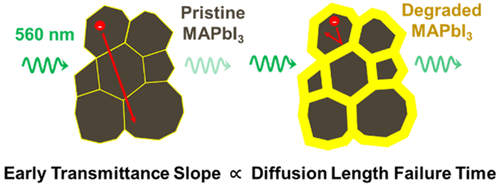当前位置:
X-MOL 学术
›
ACS Energy Lett.
›
论文详情
Our official English website, www.x-mol.net, welcomes your
feedback! (Note: you will need to create a separate account there.)
Forecasting the Decay of Hybrid Perovskite Performance Using Optical Transmittance or Reflected Dark-Field Imaging
ACS Energy Letters ( IF 19.3 ) Pub Date : 2020-03-04 , DOI: 10.1021/acsenergylett.0c00164 Ryan J. Stoddard 1 , Wiley A. Dunlap-Shohl 1 , Hongbo Qiao 1 , Yuhuan Meng 1 , Wylie F. Kau 1 , Hugh W. Hillhouse 1
ACS Energy Letters ( IF 19.3 ) Pub Date : 2020-03-04 , DOI: 10.1021/acsenergylett.0c00164 Ryan J. Stoddard 1 , Wiley A. Dunlap-Shohl 1 , Hongbo Qiao 1 , Yuhuan Meng 1 , Wylie F. Kau 1 , Hugh W. Hillhouse 1
Affiliation

|
The practicality and economic viability of hybrid perovskite solar cells hinge on their operational lifetime, and methods for forecasting the performance of perovskites under different operational stresses are urgently needed. Here, we explore the evolution of material-level optoelectronic properties as MAPbI3 degrades and discover universal behaviors where the carrier diffusion length (LD) decays before quasi-Fermi-level splitting (ΔEF), regardless of the specific stress protocol (oxygen, humidity, thermal stress, or a combination). We employ a machine learning greedy feature selection model that uses initially measured properties to predict the time it takes LD to decrease to 85% of its initial value with a prediction accuracy of 12.8%. This model reveals a strong correlation between the initial rate of transmittance change and the time until loss of transport. We translate this material-level finding to photovoltaic device-level forecasting by demonstrating that the rate of change of transmittance is equivalent to the rate of change of the spatial standard deviation of dark-field image intensity (i.e., scattered light intensity) collected in reflection mode (and thus applicable to devices with opaque contacts). This work demonstrates that transmittance and scattering methods are highly effective for accelerated material (and device) stability evaluation and forecasting.
中文翻译:

使用光学透射率或反射暗场成像预测钙钛矿杂化性能的下降
混合钙钛矿太阳能电池的实用性和经济可行性取决于其使用寿命,因此迫切需要用于预测不同操作应力下钙钛矿性能的方法。在这里,我们探索了随着MAPbI 3降解材料级光电性能的演变,并发现了通用行为,其中载流子扩散长度(L D)在准费米能级分裂(ΔE F)之前衰减,而不管特定的应力协议(氧气,湿度,热应力或两者的结合)。我们采用机器学习贪婪特征选择模型,该模型使用初始测量的属性来预测花费L D的时间降低到其初始值的85%,预测精度为12.8%。该模型揭示了透射率变化的初始速率与传输损失之前的时间之间存在很强的相关性。通过证明透射率的变化率等于反射中收集的暗场图像强度(即散射光强度)的空间标准偏差的变化率,我们将此材料级发现转换为光伏设备级预测模式(因此适用于具有不透明触点的设备)。这项工作表明,透射率和散射方法对于加速材料(和设备)的稳定性评估和预测非常有效。
更新日期:2020-03-04
中文翻译:

使用光学透射率或反射暗场成像预测钙钛矿杂化性能的下降
混合钙钛矿太阳能电池的实用性和经济可行性取决于其使用寿命,因此迫切需要用于预测不同操作应力下钙钛矿性能的方法。在这里,我们探索了随着MAPbI 3降解材料级光电性能的演变,并发现了通用行为,其中载流子扩散长度(L D)在准费米能级分裂(ΔE F)之前衰减,而不管特定的应力协议(氧气,湿度,热应力或两者的结合)。我们采用机器学习贪婪特征选择模型,该模型使用初始测量的属性来预测花费L D的时间降低到其初始值的85%,预测精度为12.8%。该模型揭示了透射率变化的初始速率与传输损失之前的时间之间存在很强的相关性。通过证明透射率的变化率等于反射中收集的暗场图像强度(即散射光强度)的空间标准偏差的变化率,我们将此材料级发现转换为光伏设备级预测模式(因此适用于具有不透明触点的设备)。这项工作表明,透射率和散射方法对于加速材料(和设备)的稳定性评估和预测非常有效。











































 京公网安备 11010802027423号
京公网安备 11010802027423号